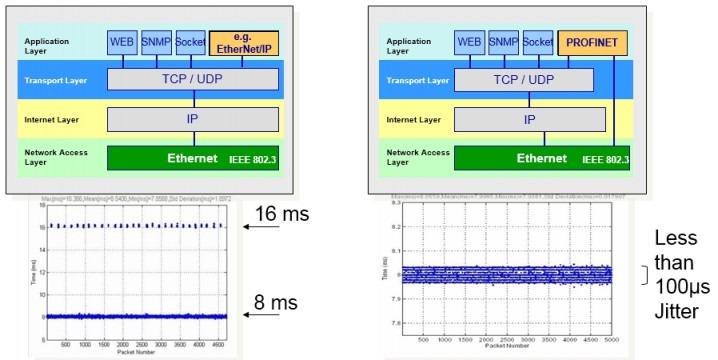In the Atlanta PROFINET one-day training class, someone was asking about using PROFINET with a controller that does not natively support it. The unusual part of this is that only one controller maker does not support PROFINET natively (you have to use a gateway). That’s what happens when you pick the controller supplier before picking the network. It’s my opinion that you should pick the network first because PROFINET has important characteristics not shared by other networks.
If you are choosing the network first, why should it be PROFINET?
The three most installed Industrial Ethernets (in rank order) are PROFINET, EtherNet/IP, and Modbus TCP.  (These are the broad-purpose Industrial Ethernets; the others are niche players.) PROFINET’s number one popularity is not a reason to choose it; it’s the result of others choosing it because of its features. Ok, maybe it is a reason to choose it. But there are plenty of other reasons.
(These are the broad-purpose Industrial Ethernets; the others are niche players.) PROFINET’s number one popularity is not a reason to choose it; it’s the result of others choosing it because of its features. Ok, maybe it is a reason to choose it. But there are plenty of other reasons.
The most important job of any network is to deliver data quickly and repeatedly. PROFINET is the clear leader here. Modbus TCP just wraps an old Modbus serial message in a TCP/IP wrapper. This limits the message size and impairs the speed and repeatability. TCP/IP is a connection-based protocol so time is spent completing the connection – a variable amount of time. Then the data has to travel through the TCP/IP stack which takes more time and introduces more variability.
EtherNet/IP uses UDP so no connection is made. But the data still has to travel through the UDP/IP stack. And, like with Modbus TCP, that introduces variable delays. PROFINET real-time data uses a standard Ethernet parameter to simply skip the UDP/IP stack and deliver the data directly to the PROFINET application. This difference was shown empirically by the University of Michigan in a head-to-head comparison*:

There are many other reasons to choose PROFINET over EtherNet/IP. Download our white paper “PROFINET versus EtherNet/IP” for details.
So choose PROFINET, then almost any controller supplier can be used and there are hundreds of choices for I/O and other devices.
–Carl Henning
*reported in the Industrial Ethernet Book article “Performance metrics for Industrial Ethernet.”
